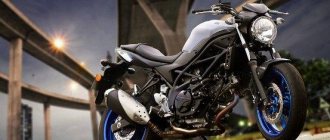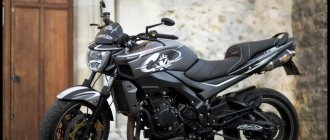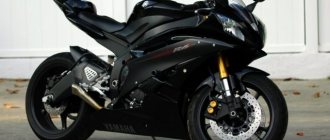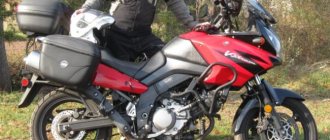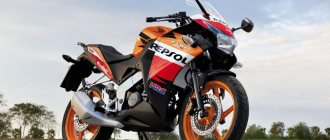Well, this is not the time to ride large-capacity vehicles, I decided and took the Suzuki SV650 for review. To a certain extent, this was a risk of not getting the slightest pleasure from the technology, given that it was preceded by serious devices stuffed with the latest technology. And yet, after spending the traditional three days with the SV, I found this bike to be quite an interesting option for a large number of two-wheeled enthusiasts. Of course, this is a great option for a first motorcycle. I am not a supporter of the idea that you need to start, for example, with 125cc and gradually increase the cubic capacity. Many very quickly cool down on such low-power equipment and begin to look for a bike that has been with them for much longer. The exception is the sports class, where there is no place for a beginner, but otherwise you need to try, especially since this Suzuki is not tall (785 mm at the saddle) and is suitable for both men and women of small stature.
Suzuki SV650 gives the impression of a very simple motorcycle, which, in fact, it is. Laconic tidy, classic fit, a hard seat, boring shapes... It belongs to the type of transport that is better to drive than to look at from the side. It is while driving that his strengths are revealed and you begin to react to the Japanese differently.
The V-twin, which sounds moderate, will please those who like a smooth acceleration. The engine is intended for those who love good traction from the bottom and are not designed to “work at the cut-off”. I came across an analogue of Suzuki Easy Start on the KTM 790 Adventure - this is when you only need a short press of the button for the bike to start. A dubious advantage overall, but convenient.
Of the electronic assistants, I really liked Low RPM Assist. This is exactly the thing that the BMW F750GS lacks. The SV650 does not jerk at low speeds when you have to use the clutch, it does not try to stall, the assistant automatically raises the speed, which gives us one of the most comfortable starts on two-wheeled vehicles. In a traffic jam, without using gas, you can safely cruise at a speed of about 10 km/h. (by the way, many competitors cope with this).
At first it seemed that the steering wheel turn was too small, but for street driving this is generally normal practice. The SV is specifically designed to overcome traffic jams, where the response to the throttle is quite predictable. In addition, 76 horses are hidden in it, and this is not so little. An excellent gearbox and adequate brakes complete the picture. In my opinion, the Suzuki SV650 is the classic middle segment of the land of the rising sun: reliable, understandable, concise... for an adequate $8150 (the price starts from this figure). But, as a lover of classic style, I would have my eye on the Suzuki SV650X.
Suzuki SV650: Review from Za Rulem magazine
Story/ . Suzuki the theme of motorcycles with two-cylinder V-twins for a long time. First, with the Suzuki TL1000S, the company drew attention to its large V-twins, then released the more flexible Suzuki TL1000R . By 1999, the concept had changed, and a completely new motorcycle was released - Suzuki SV650 . At first glance, the device was made with a clear eye on the Ducati Monster - a tubular frame in the manner of the legendary “birdcage” (but not steel, like the Italian’s, but aluminum) and a V-twin engine (more precisely, in full accordance with the Italian “icon” , here it is L-shaped) with a displacement of “six hundred and a little.” But Suzuki went further. Suzuki SV650S model was presented to the public - with a “two-eyed” half-fairing and a more “sporty” driver’s position, and in the UK the Suzuki SV650S Sport - with a full fairing. In addition, the domestic Japanese version of the “esveshka” - Suzuki SV400 - . The differences lie in the size of the engine displacement (as the name suggests, the motorcycle for the home market had 400 cc), one brake disc instead of two, and the absence of a yoke behind the passenger seat. Later, however, the designers did not save so much, and a second brake disc appeared the Suzuki SV400
The novelty was received with a bang by the public. Of course, its moderate weight, high-quality ride and high-torque engine, combined with a low price, ensured the popularity of the Suzuki SV650 . The two-cylinder engine with a displacement of 645 cm³ did not have exorbitant power, but, unlike in-line fours, it allowed you to drive confidently from the lowest revs. The buyer could choose between the classic upright riding position of the stripped version and the sportier version of the Suzuki SV650S . The engine is not particularly voracious, and the 16-liter gas tank provides the Esveshka with a good power reserve.
The motorcycle turned out to be in demand both for beginners and for those who needed a simple and unpretentious means of transportation in the metropolis. Even those who like to sharpen sliders on the track did not ignore the “esveshka”. Moreover, mono cups were held in a number of countries for owners of the Suzuki SV650 , and in the USA this motorcycle became the most popular machine at track days. By the way, there is one curious thing associated with the sale of the Suzuki SV650 in the States: in the American market in 1999, only the “naked” version was available; The Suzuki SV650S was sold in neighboring Canada and Europe. By 2000, Suzuki had corrected this situation. In 2002, Suzuki finally took care of the issue of adjusting the suspension of the Suzuki SV650 - now you can adjust the degree of spring preload at the fork (before that there were no adjustments to the front suspension).
of Suzuki SV650 was released , which received an injection engine and a cast aluminum frame, but we will talk about these motorcycles another time.
Why? / For life. Suzuki SV650 is a motorcycle that is equally suitable for both a city dweller and a suburban resident. The light and narrow motorcycle squeezes through iron boxes without any problems; the brake capabilities are quite sufficient at reasonable speeds.
The high-torque engine of the “esveshka” allows you to calmly “vomit” in city traffic jams, but the dynamics of the motorcycle are also up to par, thanks in part to its low weight. Taking the Suzuki SV650 is by no means contraindicated. Moreover, it is on a slow and technical track that the ESV has every chance to “break” heavier competitors with in-line “fours”. You can also go long-distance on the Suzuki SV650S Its arsenal includes a comfortable fit, acceptable wind protection, a tolerable level of vibration and a good power reserve.
Where to look?/ Suzuki SV650 is not difficult. There are many offers on the market, most of which are from private owners. Sometimes you can find “esveshki” from 1999–2002 in motorcycle showrooms, but this is rather a disappearing phenomenon - it’s easier to find a second-generation device there.
If you want to become the owner of Suzuki SV650 , and even without mileage in the Russian Federation, you should contact companies that deliver custom-made equipment - there are still a lot of these motorcycles on the markets of both the USA and Europe.
Tuning / A motorcycle with a classic layout provides, perhaps, the widest field for realizing desires and fantasies. You can try to build a streetfighter, a sportbike, and a tourist from it. The set of components required for tuning the SV650 will depend on the direction of creativity. There is, of course, a certain basic set of aftermarket parts, the installation of which is practiced by most device owners.
Sliders (2-5 thousand rubles) are placed in the frame without any difficulties, in the event of a fall, significantly increasing the chances of keeping the radiator and engine covers intact. You can approach the issue of protection more thoroughly by equipping your motorcycle with arches. This will cost 4–6 thousand rubles, but will significantly reduce the chances of damaging the frame in the event of an unsuccessful fall. A combined option - arches with sliders from the Russian company Crazy Iron - just under 6 thousand rubles.
The sound of the Suzuki SV650 is very stifled. And the “source” is so beautiful that it’s worth letting one enjoy the bass roar surrounding it. To do this, you just need to replace the heavy standard muffler with a direct-flow “end”. The money to “voice” the “esveshka” will require from 6 to 15–20 thousand rubles, depending on the name of the manufacturer and the amount of additional “hp” promised. It is a good idea to replace the standard brake hoses with reinforced ones. Besides the fact that the original parts from 1999–2002 are clearly not in the best condition, this will help to somewhat improve the performance of the brakes. A set of reinforced hoses from Galfer, Goodridge or Venhill will cost 5–8 thousand rubles.
A simple change of the front tire can have a positive effect on the controllability of the vehicle. Installing a slightly higher profile tire 120/70–17 (the original one is 120/60–17) changes the behavior of the device for the better.
If we talk about more serious tuning of the motorcycle, then it’s worth taking care of refining the rather primitive suspensions. The front fork of the Suzuki SV650 is either completely devoid of adjustments, or allows only adjustment of the degree of spring preload. You can change the characteristics of the fork by selecting the oil, as well as replacing the springs with “progressive” ones (3-6 thousand rubles, excluding the cost of work and oil). A kit from Race Tech that simulates the operation of a cartridge fork will cost 8–10 thousand rubles, but its installation will require additional costs, since it will be necessary to drill holes in the rods and increase the diameter of existing ones. There are many options for replacing the rear monoshock, from used ones on the GSX-R to new Ohlins or Fox. The budget, accordingly, is from 10 to 30 thousand rubles.
If you want to go long-distance on a Suzuki SV650, you can prepare the motorcycle for this according to the classical scheme. Install a windshield on a “naked” SV650 (3-6 thousand rubles) or replace the windshield with a “touring” one on an SV650S (price is about the same). Install heated handles - Oxford (3.5–4.5 thousand rubles) or Saito (2.5–3.5 thousand rubles). And add a bag for the tank (2.5–10 thousand rubles).
And on the Suzuki SV650 you can install a fairing “plow” - from a small piece of plastic covering the exhaust and oil filter, to a full-fledged fairing element that turns the Suzuki SV650S into a fully hooded motorcycle. The price of this plastic is from 4 to 8 thousand rubles.
Price/
Despite the unprecedentedly low level of retail prices for new motorcycles in the showrooms of European and North American dealers in the late 90s, in Russia used
Suzuki SV650s can hardly be classified as ultra-budget motorcycles.
Nevertheless, prices for first-generation devices usually fluctuate in the range of 130–180 thousand rubles, that is, almost at the level of domestic Japanese “four hundred”. Suzuki SV400s on sale , but I personally don’t see the point of buying such a device: at almost the same price (“four hundred” of these years cost 110–170 thousand rubles), you get a motorcycle with an engine of much more than modest displacement , and often also with a “defective” single-disc brake. Such devices will be of interest only to those who still convince themselves of the exceptional quality of equipment produced for the domestic market.
Choice/ Suzuki SV650 is a virtually problem-free motorcycle, so the “checklist” is small. The list of places that should be paid attention to when choosing a device is standard, but there are several nuances.
The first step is to understand (or even directly ask) whether the owner liked to wheelie. The fact is that the Suzuki SV650 does this very willingly, but such exercises have a detrimental effect on its health. When driving for a long time in a wheelie, due to oil starvation of the front cylinder, the liners rotate, which leads to the replacement of the connecting rod and crankshaft.
It should also be remembered that in Suzuki SV650 , the design of the timing chain tensioner leaves much to be desired. In principle, the “ticking” of the timing belt at low speeds is the norm for this engine, but if the sounds are loud enough (this is especially evident when closing the throttle and resetting the speed), then the engine is in danger of replacing a “stuck” tensioner or even a stretched chain.
It is worth paying attention to the condition of the relay regulator, although it does not fail so often. You can determine that the relay-regulator is not healthy by looking at the lower brightness of the headlights at idle than when the engine is off. It can be treated by replacement, and the sooner the better, otherwise you may end up having to replace the battery and generator. Occasionally the contact on the dashboard and in the headlight connectors disappears. This can be treated by disassembling, cleaning and treating with appropriate auto chemicals.
In view of the special popularity of the Suzuki SV650 as a road-ring machine, there is a high chance of running into a motorcycle that has had time to race to its heart’s content on overseas tracks. It is quite difficult to determine this externally; in this case, the original plastic is changed to “blind” and returned back before being sold. You should be wary of the presence of racing brake pads, high wear of brake discs (or, conversely, new discs), an abundance of tire marks on the rims and the presence of small holes in the oil and coolant filler caps (usually a wire is passed through them to prevent spontaneous unscrewing). It is also worth inspecting the air filter housing for additional holes.
Don't forget to also check the condition of the front cylinder exhaust pipe and the engine crankcase in the oil filter area. They are not protected by anything from below, and a banal drive over the curb can lead to damage.
A number of motorcycles manufactured in 2000 (with frame numbers JS1AV111200101536–102366 on the Suzuki SV650S and JS1AV133200100776–100997 on the Suzuki SV650 ) were affected by a recall campaign related to the oil pump sucking air, which led to increased wear on the crankshaft. So don't be lazy to check the numbers.
Source: magazine "Behind the Wheel"
Go to the Suzuki SV 650
- Read review Suzuki SV 650
Check out the test drives:
- Suzuki SV650: Test drive from Motorreview
A Brief History of the Suzuki Burgman Model Range
Suzuki specialists, who have perfectly mastered the production of scooters for mass consumers, decided to create equipment that is not inferior in technical characteristics to motorcycles. The first models of large scooters, called Burgman, were released 20 years ago. After the appearance on the market in 1999 of a modification of the Suzuki Burgman under the AN250 brand, the engineers did not stop there and released another model, the AN400.
Developing the model line, a few years after the release of the first maxi-scooters, the AN125 model was manufactured. In 2002, it made an impression on fans of large devices. However, this modification did not remain a new development by Suzuki specialists for long. A year later, the Suzuki Burgman 650 model appeared, and in 2004, a modernized version of the 650 model called Executive.
Review of advantages and disadvantages
The Suzuki Burgman 650 maxi-scooter has a number of serious advantages. Main advantages:
- automatic variator with the ability to switch to manual mode;
- powerful power plant providing quick acceleration;
- the ability to work on gasoline with an octane number of 92-95;
- heated steering grips and seat surfaces;
- high-quality optics that allow you to drive in low visibility conditions;
- increased volume of the luggage compartment, allowing you to place helmets and things;
- convenient placement of mirrors providing increased visibility.
In addition, the thoughtful placement of the seat and steering wheel ensures a comfortable driving position, which is important when covering long distances. The Suzuki Burgman 650 maxi-scooter has a number of serious advantages
The Suzuki Burgman 650 maxi-scooter has a number of serious advantages
Along with the advantages, this model also has weaknesses:
- increased weight and dimensions make it difficult to control the vehicle, especially in heavy traffic;
- deterioration in scooter controllability for a short period of time when quickly reaching the speed limit;
- the possibility of losing control of a vehicle stopped by emergency braking at high speed.
Controlling a scooter takes some getting used to - the many switches located on the steering wheel sometimes make novice drivers think. In addition, a tall driver will have to move closer to the passenger seat to ensure a comfortable foot position on the platform.
Nikolay, founder and ideological inspirer of the Respect.school motorcycle school:
In appearance, this is a modern classic - this is evidenced by the round headlight in combination with the digital instrumentation. There are no technical delights in the Suzuki SV650. Simple suspension, no immobilizer. It is clear that they tried to make the motorcycle as accessible, reliable and versatile as possible.
Of course, Suzuki's reliability is beyond doubt. Compared to the previous generation, the engine has not undergone significant technical changes, but it is felt that the settings have changed. Compared to its predecessor, the engine began to operate much softer and more pleasant. I really liked the motor.
Regarding ergonomics and fit: I would not say that it is comfortable to sit in the entire sitting range. With my size and texture, I try to move back, but he pulls me forward. The seat is only comfortable when you sit as close to the tank as possible. Another disadvantage is the narrow steering wheel - yes, it may be convenient in the city, but from the point of view of stability on the track, I would like to have a wider grip.
I liked the performance of the suspension. Does such a motorcycle need any adjustments or an inverted fork? I think not. He has brothers from the sports line, which are provided by the manufacturer with everything necessary. I really liked the clutch performance. Informative dashboard, presence of a gear indicator.
Once again I note the smoothness of the engine. No “bottoms”, “middles” and “tops”. Very smooth characteristics - you drive and don’t think about it. Excellent operation of the gearbox, everything turns on smoothly, clearly and quickly. An excellent device for moving around the city. If you take care of it and follow all the manufacturer’s recommendations, then this motorcycle can be considered eternal. It is one of those motorcycles that is designed with accessibility and reliability in mind from the start.
Video
- A brief inspection and sound of the Suzuki V-Strom 650 motorcycle (2012-2014).
- Test drive of the Suzuki V-Strom 650XT motorcycle (2015-).
Suzuki DL 650 V-Strom
— the younger of two representatives in the Suzuki touring enduro line. Created on the same base as its liter brother, this 650 cc bike differs from it mainly only in its engine, which is less powerful, but more economical, which, with a similar gas tank volume, gives it an impressive power reserve. The motorcycle is very popular and is found in abundance on the secondary market, successfully competing with the Honda Transalp 700 and Kawasaki Versys 650.
The Suzuki V-Strom 650 has been in production since 2004, and during this time it has undergone significant improvements. Thus, motorcycles produced in 2007 and younger received two spark plugs for each cylinder, an ABS system and an extended pendulum with a frame, which had a positive effect on fuel consumption, braking distance and directional stability. In 2012, the second generation entered the series with a changed appearance, less weight, a smaller gas tank, a more torquey engine and modified suspensions. And the third generation (since 2015) was called Suzuki DL 650XT, with another changed appearance, an adjustable windshield and increased torque due to engine settings.
Strictly speaking, the V-Strom 650 belongs to the enduro class no more than its aforementioned competitors. This, in modern terms, is a crossover motorcycle, perfectly suited for traveling on any road, but not off-road. No, the DL 650 can handle primers and graders easily, especially if you install it with all-purpose tires rather than pure road ones, but climbing it into sticky sand or muddy mud will not be the best solution. It will not be easy to hold a tall and heavy motorcycle in such conditions. However, all touring enduros are heavy bikes with a high center of gravity, which is, for example, the famous Honda XL1000V Varadero, which is generally difficult to ride for a motorcyclist with a height of less than 190 cm who does not have impressive physical characteristics.
As already written above, this motorcycle is built on the same base as its older brother - the Suzuki V-Strom 1000. Externally, the DL 650 differs from the “liter” in only one exhaust instead of two, but the main difference lies in the engine. In the case of the 650 cc version, the engine used is a modified liquid-cooled V-twin from the Suzuki SV 650 with a 90-degree camber angle between the cylinders. It produces 67 horsepower and 63 nm of torque and is capable of accelerating the motorcycle to more than 200 kilometers per hour.
However, maximum speed is by no means the main parameter for a touring enduro; this is not a sportbike. Suspensions, power reserve, reliability and comfort are much more important, and the Suzuki V-Strom 650 has everything in order. The dry weight of the motorcycle is about 215 kg, which is quite tolerable, and subjectively it does not seem too heavy. True, the height of the saddle is noticeable, so short or simply short-legged motorcyclists will have a hard time. The seating position is classic and comfortable, and the standard seat evokes a strong association with a luxurious leather sofa. The seat on it does not even think of becoming numb even after 500-700 kilometers traveled on average lousy asphalt.
We can talk for a long time about the merits of this motorcycle, but the list will be long, so let's keep it short. The Suzuki V-Strom 650 engine is moderately powerful, very torquey, capable of accelerating the motorcycle from 0 to 100 km/h in less than 5 seconds, so the dynamics are all right. Long gears are very convenient - fifth can be engaged already at 80-90 km/h. A 22-liter gas tank (on the first generation) with a fuel consumption of approximately 5 liters per 120 km/h provides more than 400 kilometers of driving without refueling, and comfortable seats, excellent wind protection and energy-intensive suspensions will add comfort to travel. The DL 650 is certainly not an enduro, but it really is a great touring bike for the money.
2022 Suzuki SV650 Specifications
- Engine: four-stroke, two-cylinder, double overhead camshafts, cylinders at an angle of 90 degrees, 645 cc, liquid cooling
- Bore and stroke: 81.0 mm × 62.6 mm
- Compression ratio: 11.2:1
- Fuel system: injection
- Starter: electric
- Lubrication: wet sump
- Chassis
- Transmission: six-speed, constant mesh
- Main drive: chain
- Chassis
- Front suspension: telescopic, coil-over, oil damping
- Rear Suspension: Linked, coil-over, oil damping, 7-position preload adjustable
- Front brakes: two two-piston calipers, 290 mm discs
- Rear Brake: Single-piston disc, 240mm disc
- Front tire: 120/70ZR17M/C, tubeless
- Rear tire: 160/60ZR17M/C, tubeless
- Fuel tank capacity: 14.4 liters/13.6 liters (CA model)
- Color: red-white
- Dimensions
- Length:2140 mm
- Width: 760 mm
- Curb weight: 195 kg/197 kg (model with ABS)
- Wheelbase: 1445 mm
- Ground clearance: 135 mm
- Seat height: 785 mm
- Warranty: 12 months, unlimited mileage



